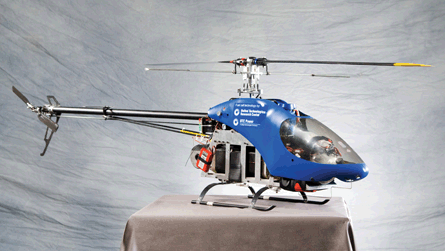A hydrogen fuel cell-powered 10kg (22lb) helicopter model with a 2m (6.55ft) rotorspan has been flown for 20min by United Technologies' research centre at the company's East Hartford campus in Connecticut, USA.
The remote-controlled electric helicopter, normally powered by batteries, used a custom United Technologies proton exchange membrane cell fuelled by a 289bar (4,200lb/in2) gaseous hydrogen source and ambient air. The 3.4kg fuel cell, including its stack's ancillary components, has a power density of 514W/kg and a maximum power output of 1.75kW. The helicopter's controls, power electronics and telemetry were also implemented by UTRC. Without payload or fuel cell, the helicopter has a 4kg mass, reaching 10kg with the stack and fuel source. It could carry a 2.27kg payload in addition or could replace that payload with more fuel, enabling the helicopter to fly for up to 1.5h.
 |
|---|
© United Technologies |
"There will be more flights for the helicopter," says UTRC director and research vice-president David Parekh. "We will contiue to improve the power density and see how you would integrate the system."
However, the company does not intend to enter the UAV market or produce fuel cells for it. Instead, it is seeking improvements in power density for its existing energy markets. Parekh says a battery might be needed for the helicopter where a payload requires more power than the fuel cells could deliver at any one moment.
UTRC's first helicopter fuel cell flight used hydrogen and oxygen, not air, and took place in October last year. A €2.7 million ($4 million) European Union research project, called muFLY Fully Autonomous Micro Helicopter, has flown a 350g quadrotor for up to 15min this year using a 10W, 150g fuel cell and a lithium ion battery.
Source: Flight International























